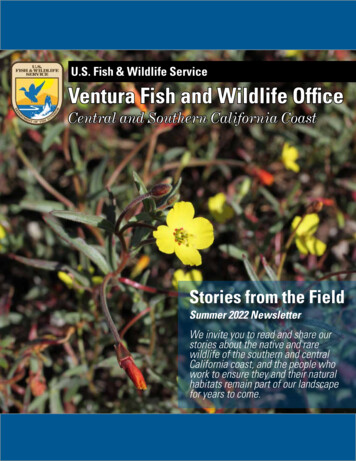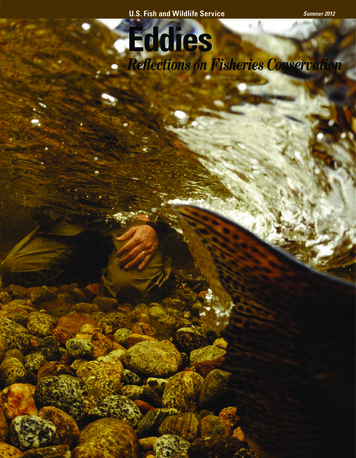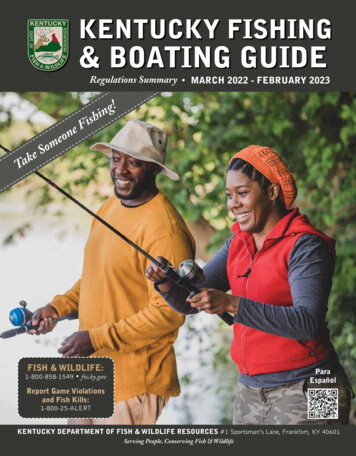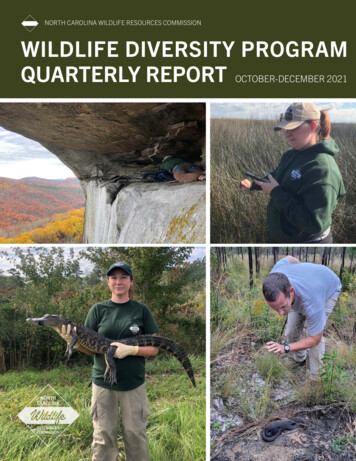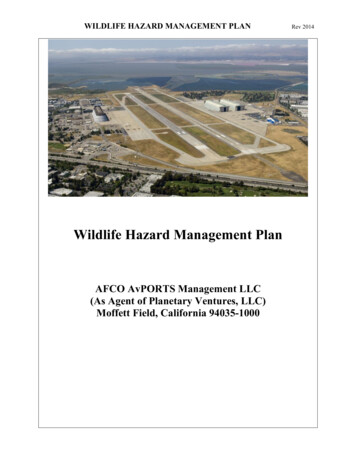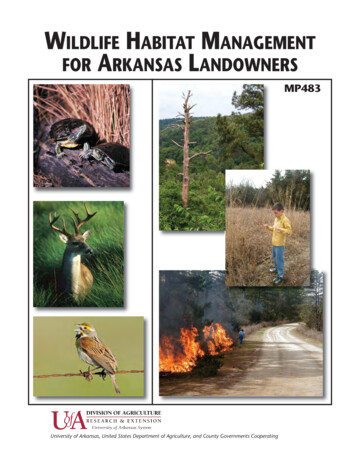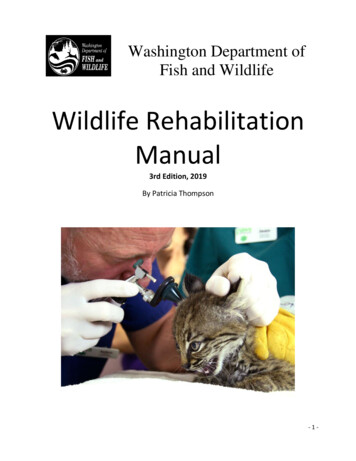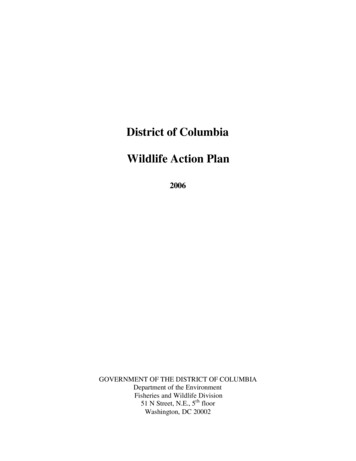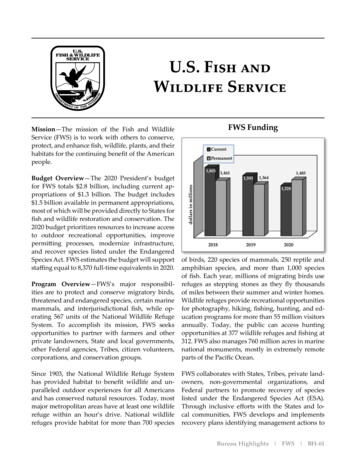
Transcription
U.S. Fish andWildlife ServiceFWS FundingMission—The mission of the Fish and WildlifeService (FWS) is to work with others to conserve,protect, and enhance fish, wildlife, plants, and theirhabitats for the continuing benefit of the Americanpeople.Permanent1,8051,4611,595dollars in millionsBudget Overview—The 2020 President’s budgetfor FWS totals 2.8 billion, including current appropriations of 1.3 billion. The budget includes 1.5 billion available in permanent appropriations,most of which will be provided directly to States forfish and wildlife restoration and conservation. The2020 budget prioritizes resources to increase accessto outdoor recreational opportunities, improvepermitting processes, modernize infrastructure,and recover species listed under the EndangeredSpecies Act. FWS estimates the budget will supportstaffing equal to 8,370 full-time equivalents in 2020.Current1,4851,3641,328201820192020Program Overview—FWS’s major responsibilities are to protect and conserve migratory birds,threatened and endangered species, certain marinemammals, and interjurisdictional fish, while operating 567 units of the National Wildlife RefugeSystem. To accomplish its mission, FWS seeksopportunities to partner with farmers and otherprivate landowners, State and local governments,other Federal agencies, Tribes, citizen volunteers,corporations, and conservation groups.of birds, 220 species of mammals, 250 reptile andamphibian species, and more than 1,000 speciesof fish. Each year, millions of migrating birds userefuges as stepping stones as they fly thousandsof miles between their summer and winter homes.Wildlife refuges provide recreational opportunitiesfor photography, hiking, fishing, hunting, and education programs for more than 55 million visitorsannually. Today, the public can access huntingopportunities at 377 wildlife refuges and fishing at312. FWS also manages 760 million acres in marinenational monuments, mostly in extremely remoteparts of the Pacific Ocean.Since 1903, the National Wildlife Refuge Systemhas provided habitat to benefit wildlife and unparalleled outdoor experiences for all Americansand has conserved natural resources. Today, mostmajor metropolitan areas have at least one wildliferefuge within an hour’s drive. National wildliferefuges provide habitat for more than 700 speciesFWS collaborates with States, Tribes, private landowners, non-governmental organizations, andFederal partners to promote recovery of specieslisted under the Endangered Species Act (ESA).Through inclusive efforts with the States and local communities, FWS develops and implementsrecovery plans identifying management actions toBureau Highlights FWS BH-61
U.S. Fish and Wildlife ServiceFacts Originated in 1871 with the purpose of studying and recommending solutions to a decline in foodfish. Manages more than 855 million acres of land and water in the National Wildlife Refuge System,composed of 567 national wildlife refuges, seven national monuments, and thousands of smallwetlands. Distributed more than 1.5 billion in 2018 mostly to States and Tribes for the conservation ofwildlife and habitat so Americans can enjoy the outdoors. Works with the Department of State and foreign governments to stem illegal wildlife trafficking byfocusing law enforcement efforts on key regions such as Southeast Asia and Africa.promote species recovery. FWS strives to preventthe extinction and promote recovery of imperiledspecies. This includes efforts to facilitate economicdevelopment planning to accommodate land usewhile avoiding conflicts with imperiled species,using the best available science as a basis for itsdecisions.The FWS Fisheries program helps safeguard interjurisdictional fisheries worth billions of dollars;rescues troubled aquatic species on the brink ofextinction; and provides recreational opportunitiesfor the public. In addition, FWS operates one historic national fish hatchery, seven fish technologycenters, and nine fish health centers. Sixty-eightnational fish hatcheries produced and distributed113 million fish in 2018 including striped bass,steelhead, lake trout, and salmon.FWS also plays a major role in the conservation ofinternational wildlife resources as the lead agencyfor implementing U.S. treaty commitments for migratory birds, endangered species, wildlife trade,arctic species, wetlands, some marine mammalspecies, and biological resources of the WesternHemisphere.Resource Management—The 2020 budget for theprincipal FWS operating account, Resource Management, is 1.3 billion.Ecological Services—The budget includes 240.0million to conserve, protect, and enhance listed andat-risk fish, wildlife, plants, and their habitats, andBH-62 Bureau Highlights FWSwithin that, prioritizes funding for Planning andConsultation and Recovery activities. The budgetincludes 107.5 million to support environmentalreviews, consultation services, and permittingfor infrastructure and other projects, which helpsavoid backlogs. The budget includes 95.0 millionto promote the recovery of listed species throughcompletion of recovery actions and 5-year speciesstatus reviews as required by the ESA. The budgetproposes 11.1 million for the listing of species. Toproactively conserve at-risk species, the budgetincludes 26.4 million for Conservation and Restoration activities, including 9.4 million for targetedcandidate conservation efforts to keep those speciesoff the threatened and endangered species lists.Habitat Conservation—The budget includes 67.8million for Habitat Conservation programs with 54.4 million to support voluntary, citizen, andcommunity-based conservation on private landsthrough the Partners for Fish and Wildlife Program. The budget includes 13.4 million for theCoastal Program to promote voluntary habitatconservation on public and private lands along thecoasts of the United States.National Wildlife Refuge System—In 2020, operationand maintenance of the refuge system is supportedat 509.5 million. Funding focuses on improvinginfrastructure and habitat while ensuring accessto public lands for wildlife-dependent recreation,including wildlife photography, hunting, andfishing.
The request includes 239.4 million for wildlifeand habitat management, focusing funding onimproving wildlife and habitat through activitiessuch as forest management to promote healthywildlife populations. The request focuses resources on improving habitat conditions using toolssuch as controlled burns and active wetland habitat management to benefit waterfowl and otherwildlife populations. The budget includes fundingto increase access to wildlife refuges and developnew and expanded outdoor recreation opportunities, including hunting and fishing. Support forthe refuge system includes 5.0 million to expandefforts to combat invasive species including establishing additional Strike Teams across the countryto apply proven early detection/rapid response(EDRR) techniques. A new Strike Team establishedin Alaska will work in partnership with the State ofAlaska to develop best practices for joint Federal/State EDRR efforts to fight invasive species.The budget request includes 80.9 million for Visitor Services. The refuge system offers a variety ofwildlife-dependent recreation opportunities andcontinues to welcome more visitors each year.With more than 100 refuges within 25 miles ofmost major cities, wildlife refuges offer excellentopportunities for more Americans, including anglers, hunters, photographers, and bird watchers,to enjoy outdoor recreation first-hand. The budgetprioritizes support for hunting, fishing, and wildlife watching, among other wildlife-dependentrecreation opportunities that benefit local communities. The request includes 43.2 million to ensurevisitors enjoy safe outdoor experiences while protecting property and resources.The request includes 146.0 million for refuge facility and equipment maintenance. The budget prioritizes maintenance of FWS-owned facilities andinfrastructure, such as water control structures andadministrative facilities. Addressing health andhuman safety deficiencies at existing facilities is thehighest priority for maintenance funding.Migratory Bird Management—In 2016, the mostrecent year in which FWS conducted the NationalSurvey of Fishing, Hunting, and Wildlife-AssociatedRecreation, 2.4 million migratory bird hunters enjoyed more than 15,600 days afield and generated 2.3 billion in economic activity. In addition, 45 million people enjoyed 4.3 million days bird watching,much of it in rural America. The budget includes 49.5 million for migratory bird management tosupport population monitoring, cooperation withStates on migratory bird management, and environmental reviews as required for developmentprojects. The 2020 budget also includes 13.1million for the North American Waterfowl Management Plan to support regional partnerships—known as joint ventures—of government agencies,nonprofit organizations, corporations, Tribes, andindividuals that conserve habitat for migratorybirds across North America.Law Enforcement—The budget provides 77.2 million for law enforcement activities investigatingwildlife crimes and enforcing wildlife laws. FWSenforces domestic wildlife laws such as the LaceyAct, which prohibits trade in certain wildlife andplants including products made from illegallylogged timber. The budget supports continuingcooperation with other nations to combat wildlifetrafficking to protect elephants, rhinos, and otherspecies by stopping illicit trade, ensuring sustainable legal trade, reducing demand for illegal products, and providing technical assistance and grantsto other nations to develop local enforcement capabilities.International Affairs—The budget includes 16.6million for technical and financial assistance tointernational partners for innovative projects thataddress wildlife poaching and trafficking and support resource conservation. The International Affairs program uses grants and cooperative agreements to work with other countries to strengthenenforcement, reduce demand for illegally tradedwildlife, and expand international cooperationto conserve wildlife and natural resources. Therequest includes funding to reduce wildlife trafficking through community outreach, awareness,and engagement with stakeholders as a meansto change harmful consumption patterns and enhance the value of wildlife in order to conserveinternational species.Bureau Highlights FWS BH-63
Fish and Aquatic Conservation—The budget requestfor Fish and Aquatic Conservation is 155.6 million, supporting access to recreational fishing andfisheries conservation. The request includes 82.2million for the operation and maintenance of theNational Fish Hatchery System. Maintenancefunding will be used to modernize hatchery infrastructure and facilities thereby reducing operatingcosts and improving research and fish productioncapabilities. FWS will continue to cooperate withFederal agency partners to ensure hatchery activities mitigate impacts of Federal water projectsvia reimbursable service agreements while prioritizing the recovery of federally listed threatenedor endangered species, restoration of imperiledspecies, and fulfillment of Tribal partnerships andtrust responsibilities.The budget proposes 73.4 million for AquaticHabitat and Species Conservation, including 16.1million to prevent aquatic invasive species fromentering our waterways and to control or eradicateestablished species that threaten ecosystems, recreation, and economic values. For example, the request includes 7.8 million to target Asian carp and 2.0 million to control invasive mussels plaguingwestern States. The request includes 14.0 millionfor fish passage improvements that enable fish touse additional habitat. The request also includes 29.7 million to maintain support for managementof subsistence fishing in Alaska and fishery monitoring, management, and restoration nationwide.General Operations—The General Operations budget totals 140.9 million. The request includes 35.8million for FWS-wide expenses, 7.0 million forconservation partnerships with the National Fishand Wildlife Foundation, and 21.4 million for theoperation and maintenance of the National Conservation Training Center. The request proposesto restructure the budget to consolidate administrative support services such as human resourcesand contracting across FWS, to realize savings andoptimize the delivery of administrative services.As part of the Department-wide reorganizationeffort, the FWS budget includes 5.7 million tosupport Interior’s 12 unified regions, relocate reBH-64 Bureau Highlights FWSsources closer to customers, and implement sharedservice solutions to better deliver operational services across the Department.Construction—The 2020 budget for Constructionis 15.7 million, of which 9.1 million is for lineitem construction projects.Land Acquisition—The 2020 budget proposes 4.5million for FWS land acquisition activities, whichincludes 9.9 million in new budget authority anda 5.3 million proposed cancellation of prior yearbalances. The budget reflects the Administration’spriority to support management of existing landsand resources over acquisition of new Federallands. The budget continues support for enactedacquisition projects. In 2020, FWS will focus oncompleting enacted acquisitions and acquiring inholdings that enhance operational efficiency.North American Wetlands Conservation Fund—The 2020 request is 40.0 million for the NorthAmerican Wetlands Conservation Fund. Fundingcontinues these cost-shared partnership projectsfor wetlands and waterfowl conservation supporting conservation and outdoor recreation.Cooperative Endangered Species ConservationFund—The 2020 budget does not request currentfunding for this account since higher priority endangered species work is funded within the FWSResource Management Account. To focus resources on core FWS operations such as habitat management and providing access to outdoor recreation,the budget proposes to cancel 31.0 million in prioryear funds related to land acquisition grants thatare inactive and for which funding is no longerneeded.Multinational Species Conservation Fund—The2020 budget includes 6.0 million for the Multinational Species Conservation Fund. Fundingleverages support from partners to protect Africanand Asian elephants, rhinos, tigers, great apes, andmarine turtles from threats including those linkedto illegal wildlife trafficking. These grants complement efforts in the FWS law enforcement program.
Neotropical Migratory Bird Conservation Fund—The 2020 request includes 3.9 million for the Neotropical Migratory Bird Conservation Fund, providing matching grants for neotropical migratorybird conservation projects throughout the WesternHemisphere.grants for projects helping to protect key migrationcorridors for iconic western species including elk,mule deer, and pronghorn antelope.Fixed Costs—Fixed costs of 7.5 million are fullyfunded.State and Tribal Wildlife Grants—The State andTribal Wildlife Grants request is 31.3 million.Within the total is 2.0 million for competitiveBureau Highlights FWS BH-65
SUMMARY OF BUREAU APPROPRIATIONS(all dollar amounts in thousands)Comparison of 2020 Request with 2019 CRItemCurrentResource Management .Construction .Land Acquisition 1/ .National Wildlife Refuge Fund .Cooperative Endangered Species Conservation Fund .North American Wetlands Conservation Fund .Multinational Species Conservation Fund .Neotropical Migratory Bird Conservation .State and Tribal Wildlife Grants.Subtotal, Current .2019 CR2020 l Wildlife Refuge Fund .Federal Aid in Wildlife Restoration .Sport Fish Restoration .Cooperative Endangered SpeciesConservation Fund 2/ .North American Wetlands Conservation Fund .Migratory Bird Conservation Account .Recreation Enhancement Fee Program, FWS .Miscellaneous Permanent Appropriations .Contributed Funds .Coastal Impact Assistance .Subtotal, Permanent 00 363 104,254 5,00001,484,77000000000 1,896-14,588 3,959 58 7500 121,233Allocation and ReimbursableAllocation .Reimbursable .Subtotal, Allocation and Reimbursable .4838581,3410004888581,346000 50 5000Total, Fish and Wildlife Service .8,4292,958,1838,3702,812,342-59-145,8411/2/The 2020 request for the Land Acquisition Account reflects a cancellation of 5.3 million in prior year balances.The 2020 request for the Cooperative Endangered Species Conservation Fund reflects a cancellation of 31.0 million in prior yearbalances.BH-66 Bureau Highlights FWS
HIGHLIGHTS OF BUDGET CHANGESBy Appropriation Activity/SubactivityAPPROPRIATION: Resource ManagementItemEcological ServicesListing .Planning and Consultation .Conservation and Restoration .Recovery .Subtotal, Ecological Services .2018 Actual2019 CR2020 00240,022-7,753 1,937-5,955 3,968-7,803Habitat ConservationPartners for Fish and Wildlife.Coastal Programs .Subtotal, Habitat Conservation 7,792 2,7840 2,784National Wildlife Refuge SystemWildlife and Habitat Management .Visitor Services .Refuge Law Enforcement .Conservation Planning .Refuge Maintenance .Subtotal, Nat'l Wildlife Refuge 50146,042509,529 6,296 7,536 5,141-2,523 6,573 ,21716,623 1,239 327 807140,952140,952143,325 2,373Conservation and EnforcementMigratory Bird Management .Law Enforcement .International Affairs .Subtotal, Conservation andEnforcement.Fish and Aquatic ConservationNational Fish Hatchery Operations .Maintenance and Equipment .Aquatic Habitat and SpeciesConservation .Subtotal, Fish/Aquatic Conservation .55,82222,92055,82222,92056,39025,846 568 4-9,000Cooperative Landscape Conservation .12,98812,9880-12,988Science SupportAdaptive Science .Service Science .Subtotal, Science Support 6,365143,829143,8290-143,829General Operations (old structure)Central Office Operations .National Conservation Training Center.National Fish and Wildlife Foundation .Regional Office Operations .Servicewide Bill Paying .Subtotal, General Operations (oldstructure) .Bureau Highlights FWS BH-67
APPROPRIATION: Resource Management (continued)General Operations (new structure)Central Office Operations .Management and Administration.Servicewide Bill Paying .National Fish and Wildlife Foundation .National Conservation Training Center.Subtotal, General Operations (newstructure) 0021,426 21,804 54,866 35,770 7,000 21,426[142,829][142,829]140,866 140,866TOTAL APPROPRIATION .1,279,0021,279,0021,257,161-21,841Detail of Budget ChangesItem2020 Changefrom 2019 CRTOTAL APPROPRIATION .-21,841Ecological Services .Listing .Listing Activities .Fixed Costs .Planning and Consultation .General Program Activities .NEPA Permitting .Gulf Coast Restoration .Fixed Costs .Conservation and Restoration .Environmental Contaminants .Candidate Conservation .Sagebrush Steppe Ecosystem .Fixed Costs .Recovery .De-Listing & Down Listing .General Program Activities .Fixed Costs .-7,803-7,753-7,877 124 1,937 6,101-2,500-3,002 1,338-5,955-1,785-2,918-1,506 254 3,968-1,393 4,520 841Habitat Conservation.Partners for Fish and Wildlife.Environment Data Quality and Access(WA Salmon Recovery) .General Program Activities .Washington Regional FisheriesEnhancement Groups .Fixed Costs .Coastal Programs .General Program Activities .Hood Canal Salmon EnhancementGroup.Long Live the Kings .Fixed Costs . 2,784 2,784BH-68 Bureau Highlights FWS-643 4,391-1,285 3210 183-184-184 1852020 Changefrom 2019 CRNational Wildlife Refuge System.Wildlife and Habitat Management .General Program Activities .Invasive Species .Inventory and Monitoring.Fixed Costs .Visitor Services .General Program Activities .Urban Wildlife Conservation ProgramYouth and Careers in Nature .Fixed Costs .Refuge Law Enforcement .General Program Activities .Fixed Costs .Conservation Planning .Refuge Maintenance .Annual Maintenance .Deferred Maintenance .Equipment and Vehicle Management(Transfer to Maintenance Support) .Maintenance Support .Maintenance Support .Transfer from Equipment and VehicleManagement .Fixed Costs .Youth Conservation Corps . 23,023 6,296 975 5,000-1,044 1,365 7,536 8,106 1,000-2,000 430 5,141 4,929 212-2,523 6,573 950 3,090Conservation and Enforcement .Migratory Bird Management .Conservation and Monitoring .General Program Activities .Aviation Management.Monitoring .Fixed Costs . 2,373 1,239 956-1,527 1,237 988 258-4,000 7,182 2,627 4,000 555-649
APPROPRIATION: Resource Management (continued)Detail of Budget ChangesPermits.Permitting.Fixed Costs .Federal Duck Stamp - Fixed Costs .North American WaterfowlManagement Plan - Joint Ventures .General Program Activities .Fixed Costs .Law Enforcement .General Program Activities .Wildlife Trafficking.Fixed Costs .International Affairs .International Conservation .General Program Activities .Arctic Council Support .Wildlife Trafficking.Fixed Costs .International Wildlife Trade .General Program Activities .Fixed Costs .Fish and Aquatic Conservation .National Fish Hatchery Operations .General Program Activities .Aquatic Animal Drug ApprovalProgram .Washington State Mass Marking.Fixed Costs .Maintenance and Equipment .Annual Maintenance .Fixed Costs .Aquatic Habitat and SpeciesConservation .Habitat Assessment and Restoration .General Program Activities .Chehalis Fisheries Restoration .DE River Basin Conservation Act .Klamath Basin RestorationAgreement.Fixed Costs .Population Assessment and CooperativeManagement.General Program Activities .Lake Champlain Sea Lamprey.Fixed Costs .Aquatic Invasive Species .Asian Carp .Lake Tahoe Watercraft Inspections .Fixed Costs .Cooperative Landscape Conservation .Ecosystem Restoration - Gulf Coast .General Program Activities.2020 Changefrom 2019 CR 275 254 21 80-62 62 327-915 986 256 807 431-153-550 1,084 50 376 290 86-9,000 568 2,067-400-1,475 376 2,926 2,888 38-12,494-6,484 89-268-5,000-1,390 85-409-517-489 597-5,601-2,566-3,088 53-12,988-1,000-11,9882020 Changefrom 2019 CRScience Support .Adaptive Science .Ecosystem Restoration - Gulf Coast .General Program Activities .Service Science .General Program Activities .White-Nose 0General Operations (new structure) .Central Office Operations .Office of the Director .General Program Activities .Internal Transfer: General OperationsRestructure .Diversity Office .General Program Activities .Internal Transfer: General OperationsRestructure .External Affairs .General Program Activities .Internal Transfer: General OperationsRestructure .Native American ProgramsCoordination Office .Regional Directors .Internal Transfer: General OperationsRestructure .Management and Administration.Joint Administrative Operations .Internal Transfer: General OperationsRestructure .General Program Activities .Information Resources and TechnologyManagement .General Program Activities .Internal Transfer: General OperationsRestructure .Department Reorganization.Servicewide Bill Paying .Working Capital Fund (less realtyappraisal) .Worker's Compensation .Fixed Costs .National Fish and Wildlife
refuges as stepping stones as they fly thousands of miles between their summer and winter homes. Wildlife refuges provide recreational opportunities for photography, hiking, fishing, hunting, and ed. ucation programs for more than 55 million visitors annually. Today, the public can access hunting opportunities at 377 wildlife refuges and fishing at



